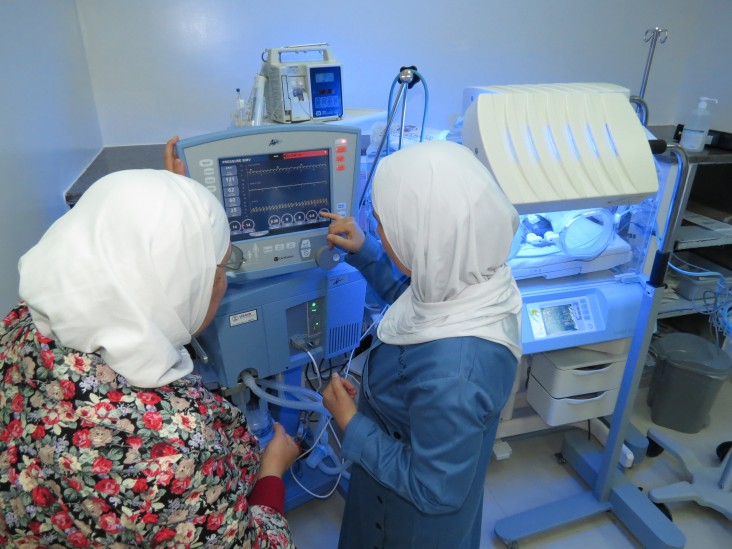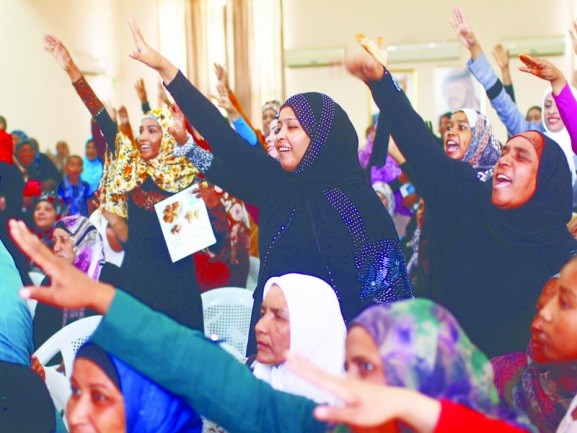
Overview
The United States is the largest donor to the health sector in Jordan, providing approximately $445 million between 2000 and 2015. USAID’s health program works to improve family planning and reproductive, maternal, newborn and child healthcare services, contributing to significant reductions in maternal and infant mortality. During the past decade, USAID also renovated and provided state-of-the-art equipment and furniture to 25 public hospital departments.
CHALLENGES

With one of the fastest growing populations in the world, the Government of Jordan (GOJ) recognizes that population issues are central to its development objectives. Despite Jordan’s status as an upper-middle income country with a relatively modern health system, the unrest in the region, coupled with a population that is expected to double to 13 million by 2040, has begun to significantly strain Jordan’s health system.
As of February 2015, more than 619,000 Syrian refugees were registered in Jordan (the GOJ estimates a total Syrian population in Jordan of 1.4 million) increasing pressure on Jordan’s health system. Outbreaks of serious diseases within Syria are also a threat to neighboring countries, as evidenced by a 2013 measles outbreak in Jordan, the first in nearly two decades. These issues shift resources from other priorities such as the provision of high-quality maternal, newborn and child healthcare in addition to family planning and reproductive health services.
Although Jordan has experienced significant reductions in maternal and infant mortality levels in recent years (19 per 100,000 and 17 per 1,000 live births respectively), efforts must continue to improve obstetric and neonatal care in order to sustain these gains during a time of unprecedented strain and shifting priorities.
CURRENT PROGRAMS
Recognizing that population increases can hinder socioeconomic progress, the GOJ set a goal of reducing the 2012 fertility rate of 3.5 children per woman to 3.0 by 2017. For this reason, much of USAID’s programming focuses on improving the quality of, and access to, family planning and reproductive health services, while public outreach campaigns seek to increase the number of Jordanians requesting and using modern family planning and reproductive health services. Additionally, maternal, newborn and child healthcare activities focus on improving key aspects of in-hospital obstetrical and neonatal care and scaling-up advanced interventions. USAID also focuses on improving the quality of healthcare systems through enhancing service delivery, workforce development, knowledge and information systems
management and infrastructure improvements.
Improving Family Planning and Reproductive Health Services:
1) Increasing awareness, availability, and the use of high-quality women’s health and voluntary family planning services; 2) strengthening the family planning policy environment; and 3) training female providers to deliver family planning and reproductive health services and counseling to increase the use of modern family planning methods.
Ensuring Safer Pregnancies and Deliveries:
1) Upgrading obstetric and neonatal wards at public sector hospitals; 2) institutionalizing improved protocols and systems at primary health care centers and hospitals; 3) providing competency-based training for service providers; and 4) expanding community mobilization and outreach.
Delivering Better Care by Strengthening Health Systems:
1) Developing human resources; 2) improving supervision and monitoring; 3) strengthening health management information systems; 4) developing accreditation systems for hospitals and clinics; and 5) developing systems for continuing medical education.
IMPACT & RECENT ACHIEVEMENTS
Recent USAID-supported achievements include:

- Helped reduce total fertility rate from 4.4 children in 1997 to 3.5 in 2012 and increased modern contraceptive use from 27 percent in 1990 to 42 percent in 2012.
- Helped reduce maternal mortality from 41/100,000 in 1995 to 19/100,000 live births in 2008.
- Renovated, equipped and furnished 25 hospital departments and 22 family planning clinics over the last five years.
- Introduced post-partum and post-miscarriage family planning services in 20 public hospitals.
- Conducted more than 1.4 million family planning counseling visits, which reached over 677,000 low-income women, generated nearly 90,000 acceptors of modern family planning methods, and tested home-based counseling of couples to increase male involvement in contraception
- Established the Health Care Accreditation Council.
- Assisted the Ministry of Health in developing and utilizing critical management information systems such as perinatal, maternal, and child health information systems.
- Trained more than 15,000 public healthcare staff.
- Established 106 community health committees that work with health center staff to improve understanding of health issues within the local community and promote healthy behavior.
JORDAN HEALTH FACTS
- Jordan’s population: 6.7 million; annual growth rate: 2.2%
- Modern contraceptive prevalence rate: 42% (a rate of 75% isneeded for replacement fertility)
- Average family size: 5.4
- Maternal mortality: 19 per 100,000 live births
- Infant and under-5 child mortality: 17 and 21 per 1,000 live births
- Half of all Jordanians rely on public-sector healthcare services
- Non-communicable diseases (NCDs) are the leading cause of death in Jordan
- Prevalence of some NCDs among Jordanian adults: Diabetes, 16%; hypertension, 26%; obesity, 36%
- Half of adult men smoke
- 32% of children age 6-59 and 34% of women age 15-49 are anemic.
Current Projects:
Jordan Census Project (J-CenP)
Jordan Communication, Advocacy and Policy (J-CAP)
Princess Rahma Pediatric Hospital Expansion








Comment
Make a general inquiry or suggest an improvement.